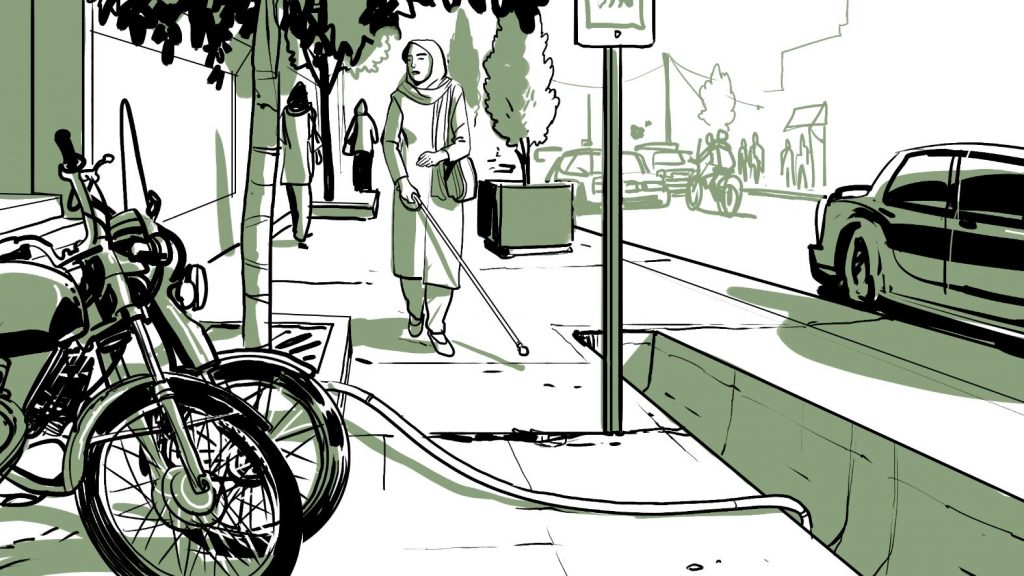Obstacles for Blind People
 Blind persons are hampered by the lack or low quality of tactile tiles or paving (raised bumps and ridges) on metro and bus station floors to help guide them while walking.[139]Most blind persons interviewed said that they avoid using buses because buses often stop before or after the designated area, and the bus stops are not verbally announced. Regular buses may stopetween designated stops to let passengers get on and off, which hinders the ability of a blind person to count stops as a means of orienting in the absence of announcements.[140]
Blind persons are hampered by the lack or low quality of tactile tiles or paving (raised bumps and ridges) on metro and bus station floors to help guide them while walking.[139]Most blind persons interviewed said that they avoid using buses because buses often stop before or after the designated area, and the bus stops are not verbally announced. Regular buses may stopetween designated stops to let passengers get on and off, which hinders the ability of a blind person to count stops as a means of orienting in the absence of announcements.[140]
The lack of tactile strips or tiles indicating the platform edge is dangerous for people who are blind, and the absence of this critical safety measure has led to serious accidents and at least one death in the Tehran metro. In October 2010, a blind teacher and mother of two was struck and killed by a train after falling off the platform and onto the rails in Tehran’s Khazaneh station.[141] In 2014, a blind man was injured after falling from the platform in Tehran’s Hassanabad station. He told the Iran Sepid newspaper,
I went to the platform and thought that the train I could hear was the one I should get on… but it was for the other side. So I stepped forward and fell on the platform instead. If they hadn’t taken me off [the tracks], I wouldn’t be alive.[142]
In 2016, Tehran Metro officials reported that all station staff, including the heads of stations, are now required to approach persons with disabilities and others who might need help in navigation and assist them in boarding trains.[143] Yet, this step is insufficient to ensure the safety of people who are blind or have low-vision in metro stations.
Blind persons also described various barriers on sidewalks that made them difficult and even dangerous to navigate.[144] For example, Laleh, a 29-year-old blind woman, told us about the barriers she encounters in Tehran: motorbikes parked on the sidewalks, potted plants, holes in the sidewalk, stairs, and uneven ground. She said:
I can’t count how often I have hurt my arm by bumping into motorbike handles, or hit my head or chin on something, or fallen into an uncovered ditch. I call some of these sidewalks “death stations.”[145]
Laleh said that she sometimes chooses to walk on the street to avoid these obstacles. “I find streets safer because there is only [the] risk of [a] car accident and I can walk faster,” she said.[146] Bahram, a 36-year-old blind man living in Karaj (Iran’s fourth largest city), said that in 2016, his foot became stuck in a hole in the sidewalk, and he fell. “I had surgery, but I still can’t fully bend my leg,” he said.[147]
Tactile paving that can help guide people with visual disabilities on sidewalks and across intersections are installed in some streets. But blind persons reported that the lack of quality, improper installation, and non-observance of accessibility standards often mean that these lines are useless.[148] For example, Mahmood, a blind man living in a southern Iranian city, explained that officials used yellow material on sidewalks, apparently to guide people with low-vision, but the material is not sufficiently raised to be recognized by his white cane.[149] Many blind persons said that because of improper installation, tactile lines often guide them into poles, trees, or telephone booths. Not knowing what tactile lines are for, street vendors may place their carts on them.[150]
In a 2016 media interview, the head of the Secretariat of the National Headquarters to Follow-up on Accessibility blamed subcontractors hired by municipalities for improper installation of tactile lines: “This is due to the lack of training for those subcontractors and has caused many injuries and issues for blind persons.”[151]




